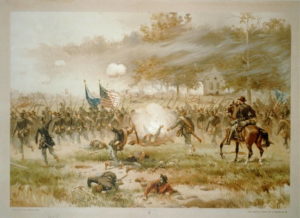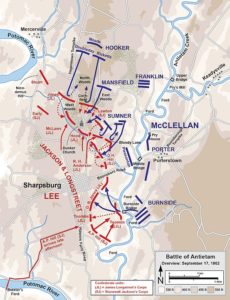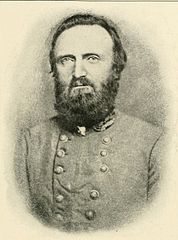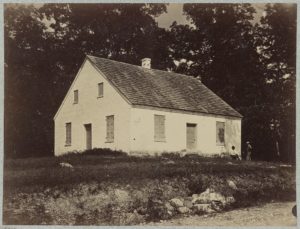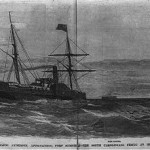A Place Of Peace Surrounded By War
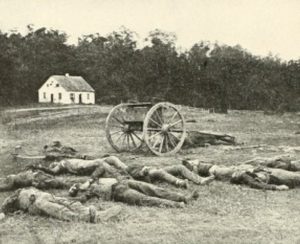
Antietam Dunker Church with Yankee and Rebel dead killed on the morning of September 17, 1862. Photograph by Alexander Gardner.
The Battle of Antietam was fought on September 17, 1862. This one-day battle left a terrible carnage on the beautiful and pastoral countryside of Sharpsburg, Maryland. In United States history, Antietam is the battle where the most casualties in one day of fighting occurred. At Antietam, there were more American dead than at Pearl Harbor, D-Day, or at 911. Over 3,600 were killed and over 19,000 were wounded, missing, or captured.
In the middle of the violent Antietam battlefield stood the whitewashed Dunker Church. The Dunker Church was a place meant for the preaching of the Gospel of Christ, where the good news message of love, forgiveness, peace, and salvation was faithfully believed and taught.
The Dunkers – German Baptist Brethren
Where Did The Name “Dunker” Come From, And What Does It Mean?
The congregation of the Dunker Church were members of the German Baptist Brethren which began in Germany in 1708. In Germany, they baptized adults in a local river, which was uncommon for the time. Usually, infants were baptized in a church by sprinkling water on them. During the German Baptist Brethren river baptism, the person would be completely submerged, or dunked, into the river water. In Germany, The German Baptist Brethren had the nickname of “Tunkers,” but when they began arriving in Maryland during the middle 1700s the nickname “Tunkers” became “Dunkers” because of their baptismal practice. The number of Dunkers in the Sharpsburg, Maryland area grew large enough so they could open their own church building in 1853.
What Were The Dunkers Like?
The Dunkers believed in a literal interpretation of the New Testament. They were similar to the Quakers, the Amish, and the Mennonites in their beliefs and the Dunkers often associated with these other Protestant denominations. The Dunkers did not like any type of indulgence. They were against drinking alcohol, violence, slavery, and gambling.The Dunker Church was built in 1852 on land given to the Dunkers the previous year by Sharpsburg farmer Samuel Mumma. In its early years, about six local farm families made up the membership of the Dunker Church. The church was a plain whitewashed building without a steeple. The Dunkers felt a steeple was too extravagant. Inside the church, there were no paintings or other artwork, and the wooden benches were hard and plain. The women entered the church from a door oriented to the south and the men entered from a door oriented to the east. There were no musical instruments and singing was done a capella. The Dunkers were modest, simple, and plain in the way they dressed and lived. Although the Dunkers were opposed to slavery, they were pacifists and would not serve in the military, not for the North or for the South. Their beliefs prohibited them from taking up arms.
During Dunker services, the pastor would stand in the front of the church at a table with a Bible. The pastor would give a sermon, and there would be singing. Occasionally, a circuit pastor may instead give the sermon. The church service was long, it would last three to four hours and perhaps run into the afternoon. Religion was central in the lives of the Dunkers and their church services were a way for them to meet regularly in fellowship with friends, neighbors, and relatives. The Dunkers would enjoy peaceful worship in the years before the Civil War.
As the Dunkers worshiped in their whitewashed church on Sunday, September 14, 1862, they knew the Civil War was coming their way. As they looked toward South Mountain, which was only seven miles away to the east, they could clearly see smoke and hear cannon echoing from the Battle of South Mountain. After that Sunday service, the Dunkers went to the nearby farm of Samuel Mumma for dinner. On Tuesday, Confederate infantry and artillery were in position around the Dunker Church, ready for the battle beginning on Wednesday. During the battle, the Dunkers and most citizens had left to find safety away from the battlefield. By the end of the Battle of Antietam, the Dunker Church would be riddled by cannon and small arms fire, the now bloody landscape around it torn and littered with the remains of the great battle. The Samuel Mumma farm was in ashes. The Dunker Church would forever be a part of the Antietam battlefield.
 Does reading about Civil War history from long and dry academic-like books bog you down and cause you to lose interest? Would you like to read interesting stories based on facts of the Civil War, stories that inform you and move along with the war’s history? Does having to read from cover to cover tire you and cause you to drag through a history book? Would you prefer the freedom to skip around in a book and learn story-by-story about the Civil War? If you answered “yes” to any of these questions, then the factual stories in 125 Civil War Stories and Facts will help you learn Civil War history. The stories are informative and entertaining and it’s a fun way to learn about the Civil War. Do books like Civil War Trivia and Fact Book by Webb Garrison or The Civil War: Strange & Fascinating Facts by Burke Davis interest you? Then you will find 125 Civil War Stories and Facts follows in their tradition of providing the reader with rich and interesting information about the Civil War. Available as a Kindle device e-book or as a paperback. Get 125 Civil War Stories and Facts now!
Does reading about Civil War history from long and dry academic-like books bog you down and cause you to lose interest? Would you like to read interesting stories based on facts of the Civil War, stories that inform you and move along with the war’s history? Does having to read from cover to cover tire you and cause you to drag through a history book? Would you prefer the freedom to skip around in a book and learn story-by-story about the Civil War? If you answered “yes” to any of these questions, then the factual stories in 125 Civil War Stories and Facts will help you learn Civil War history. The stories are informative and entertaining and it’s a fun way to learn about the Civil War. Do books like Civil War Trivia and Fact Book by Webb Garrison or The Civil War: Strange & Fascinating Facts by Burke Davis interest you? Then you will find 125 Civil War Stories and Facts follows in their tradition of providing the reader with rich and interesting information about the Civil War. Available as a Kindle device e-book or as a paperback. Get 125 Civil War Stories and Facts now!
The Dunker Church During The Battle Of Antietam
An Iconic Battlefield Landmark
The location of the Dunker Church on the Antietam battlefield made it an important landmark because it was on high ground and in the center of the Confederate line. The church is next to the Hagerstown Pike and on a natural ridgeline that provided the Confederates a good place to establish a defensive position on their left flank.
The Dunker Church was a visual reference point for both the Confederates and the Federals during the Battle of Antietam because its distinctive whitewashed walls stood out well on the battlefield. The morning the battle began on September 17, 1862, was foggy and drizzly, and the smoke of battle made it difficult to pick out landmarks. The whitewashed Dunker Church was clearly visible through the fog, drizzle, and smoke, it became a reference point for both sides. The Yankees knew the Rebels were near that whitewashed building, so that’s where they focused their attention in wave after wave of attack. The Dunker Church itself was not chosen by the Confederates to be a defensive position because of its physical structure. Rather, the church just happened to be at the place on the battlefield which gave the Confederates their best defensive position. Thomas Jonathan “Stonewall” Jackson’s men were in camp behind the Dunker Church and along the Confederate line north and south of the church.
- Early on September 16, 1862, the Confederates began to gather and organize at Antietam. Hood’s division along with some brigades of Jone’s Division, took a position which overlooked the Hagerstown Pike and stretched from the Dunker Church and into the West Wood.
- The battle began at dawn on September 17, with Joseph Hooker’s Union I Corps moving in attack down the Hagerstown Pike, his goal was the high ground around the Dunker Church. Thomas Jonathan “Stonewall” Jackson had a defensive position near the Dunker Church that stretched in a line from the West Woods nearby the church to across the Hagerstown Pike and to the south end of the Miller Cornfield. Stonewall had four brigades held in reserve in the West Woods.
- The trees around and near the Dunker Church made excellent cover for Confederates. Men of the 48th North Carolina were around Dunker church and the 30th Virginia were nearby on the Hagerstown Pike awaiting more regiments.
- The Federals used the church as a reference point during the battle, it was a landmark located in the middle of the fight as wave after wave of Federal advances were made toward the Confederate left flank.
- The smoke of battle made it difficult for men of Federal Brigadier General George Greene’s 2nd Division to see. The prominent whitewashed Dunker Church was only fifty yards away from them, but they had a hard time seeing it through the smoke.
- The Union 1st and 2nd Corps came from the east and pushed west across the Antietam battlefield, some of them were able to make it as far as the West Woods behind the Dunker Church.
- The Confederate Texas Brigade came from behind the Dunker church to meet the Union 1st Corp.
- There was action and battle swirling around the Dunker Church. A brigade led by Colonel Henry Stainrook of Brigadier General George Greene’s 2nd Division extended the Federal line southwest of the Dunker Church. Only fifty yards to the west of the Dunker Church, six twelve-pounder Napoleon cannons of Battery D, 1st Rhode Island Light Artillery were ordered by Captain J. Albert Monroe to fire on Confederates on an exposed field south of the Dunker Church.
- Confederate General Jeb Stuart had Colonel Stephen D. Lee with his four batteries of artillery in position across from the Hagerstown Pike on a piece of high ground near the Dunker Church. They were under strong fire from Union artillery located on a ridge behind the North Woods, and other artillery two miles east of Antietam Creek. This artillery duel between the Confederates and the Federals was described by Colonel Lee as “artillery hell.”
- The epicenter of the Battle of Antietam is a triangular piece of land bordered roughly by the West Woods, the Cornfield, and the Mumma Farmstead, it is where a significant portion of the Battle of Antietam took place. The closeness of the Dunker Church to the epicenter made it a battlefield landmark. Concentrated fighting took place near and on the property of the Dunker Church because of its location on the left flank of the Confederate line, and because of its closeness to the West Woods.
- The Union and Confederate commanders made mention of the Dunker Church in their battle reports. Both Confederate Thomas Jonathan “Stonewall” Jackson and Union General “Fighting Joe” Hooker spoke of the Dunker Church in their battle reports.
- The Dunker Church was scarred after the Battle of Antietam. Bullet holes riddled its whitewashed walls, and artillery had damaged the church’s roof and walls. The Dunkers repaired their small church and in 1864, worship services were held again.
Immediately after the battle, the Dunker Church served another role as a makeshift hospital for the wounded. It was not used as a proper hospital because it was too small, and the church had no supply of water or food. The Dunker Church was used instead as a place where the wounded could be brought and evaluated, like modern-day triage. Perhaps the wounded received some immediate treatment at the Dunker Church and then were moved on to other places where they could be better cared for. Usually, one of the nearby family farms made a much better, though not perfect, hospital than the Dunker Church did. It is possible the Dunker Church was also used as an embalming station.
The Dunker Church continued to be a point of reference after the battle. It was a common and easy-to-find location to meet and gather for army commanders, the soldiers, and for the local people whose help was now greatly needed. There is a sketch made by Civil War artist Alfred Waud that depicts a truce being made near the Dunker Church between Confederates and Federals in order to exchange wounded and to bury dead.
The Dunker Church After The Battle Of Antietam
A Big Whirlwind
After the Battle of Antietam, the Dunkers and the local citizens worked hard at putting their lives and property back together. They wanted to get their lives back to normal, which was an impossibility after the bloodshed of war.
The Dunkers (They had officially changed their name to the Church of the Brethren. Note: A comment by Rebecka Snell Labson tells us that the name Church of the Brethren was not officially adopted until 1908.) moved to a new church on Main Street in Sharpsburg in 1899. After the move, their old church on the Antietam battlefield was mostly ignored, it was seldom used and fell into neglect and disrepair. As time went on, the old Dunker Church continued its physical decline. Tourists to the Antietam battlefield sometimes took bricks from the church walls as souvenirs. The damage from the Battle of Antietam to the church building continued to worsen. A strong windstorm flattened the church into a pile of rubble on April 24, 1921. The Dunker Church congregation did not have the financial ability to repair the old church.
The Dunkers deeded the old church to the Samuel Mumma family, who had originally donated the church’s property to the Dunkers. The Mummas then sold the Dunker Church property at auction to a Sharpsburg grocer named Elmer Boyer. Boyer salvaged what was left of the Dunker Church building and stored the material in a shed. He then sold the Dunker Church property to Charles Turner.
Get Your Cold Beer Here
Charles Turner used the Dunker Church foundation to build a new frame structure. Being an entrepreneur, Turner used his building during the 1930s and 1940s as a lunch counter and to sell souvenirs. Tourists of the Antietam Battlefield could quench their hunger and thirst by treating themselves to refreshments and food at Turner’s lunch counter. Turner’s efforts were not appreciated. His lunch counter and souvenir stand were considered an eyesore and his building was much different in appearance from the original Dunker Church. Turner even sold beer at his lunch counter, a great contrast to the strict beliefs of the Dunkers who abstained from drinking alcohol. Attempts were made for years to buy the Dunker Church property back and restore it to its condition as during the Battle of Antietam.
The Revival Of The Dunker Church Building.
In 1951, things began to change favorably for the Dunker Church property when there were plans to widen the nearby Hagerstown Pike. The Dunker Church is so close to the Hagerstown Pike that the original church property would be encroached upon, and the historical preservation of the Dunker Church site lost, with the widening of the road. The Washington County Historical Society came to the rescue by raising enough money to purchase the Dunker Church property, and to raze Turner’s frame building with the lunch counter and souvenir stand. The Washington County Historical Society then donated the Dunker Church property to the Federal government. The Federal government was unable to do anything with the Dunker Church property for a decade because the Korean War was being fought and money was not available. All tourists saw of the Dunker Church during this time was its remaining foundation.During the Civil War Centennial national attention focused on the history and importance of the Civil War. Many events were held during the Civil War Centennial to commemorate the Civil War and to educate people about it. Maryland Governor Millard Tawes allocated money for the rebuilding of the Dunker Church and restoration plans were made by historians and architects. Amazingly, Elmer Boyer still had original Dunker Church materials stowed away in his shed. Work began in the fall of 1961 to rebuild the Dunker Church. By the following summer in 1962, the Dunker Church was back with its historical appearance and place on the Antietam battlefield.
Re-dedication of the Dunker Church, September 2, 1962
Maryland Governor Millard Tawes
“On a field shrouded with smoke, the church alone was the only visible landmark. And so, this Dunker Church stood out as a beacon by which commanders took their direction and men found their way through the smoky chaos of battle. May it stand in peace as it did in war, as a beacon to guide those searching their way through the darkness. May it stand throughout all ages as a symbol of mercy, peace, and understanding.”
If you visit the Antietam battlefield today, you will find the Dunker Church much as it was in 1862. You can go inside and see the wooden benches where the Dunkers sat during their long services, you can hear your voice and other’s echo through the simple and barren building. A trip to visit the Antietam National Battlefield is worthwhile if you want to learn about the history of the Civil War.
Learn Civil War History Podcast Episode Eleven: The Story Of Antietam’s Dunker Church – Part Two
Immediately after the battle, the Dunker Church served as a makeshift hospital for the wounded. It was not used as a proper hospital because it was too small, and it had no supply of water or food. The Dunker Church was used as a place where the wounded could be brought to and evaluated, like modern-day triage.
The Dunker Church continued as a reference point after the battle. It was a common and easy-to-find location to meet and gather for army commanders, soldiers, and for the citizens whose help was now so greatly needed. There is a sketch by Civil War artist Alfred Waud that depicts a truce meeting between the Rebels and the Yankees near the Dunker Church in order to exchange wounded and bury the dead.
Learn Civil War History Podcast Episode Ten: The Story of Antietam’s Dunker Church – Part One
The Battle of Antietam or the Battle of Sharpsburg as the South called it, was fought on September 17, 1862. This one-day battle left a terrible carnage on the beautiful and pastoral countryside of Sharpsburg, Maryland. Antietam is the battle in United States history where the most casualties occurred in one day. At Antietam, there were more American dead than at Pearl Harbor, D-Day, or at 911. Over 3,600 were killed and over 19,000 were wounded, missing, or captured.
In the middle of the Antietam battlefield stood the whitewashed Dunker Church. The Dunker Church was meant to be a place for the preaching of the Gospel of Christ. It was where the good news message of love, forgiveness, peace, and salvation was faithfully believed and taught. The congregation of the Dunker Church were members of the German Baptist Brethren which began in Germany in 1708. In Germany, they baptized adults in a local river, which was uncommon for the time.
